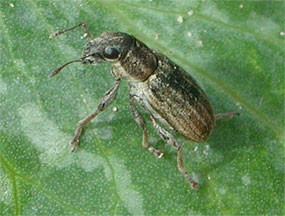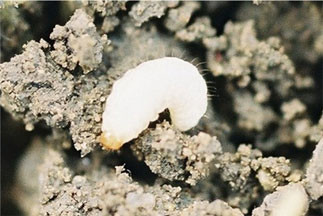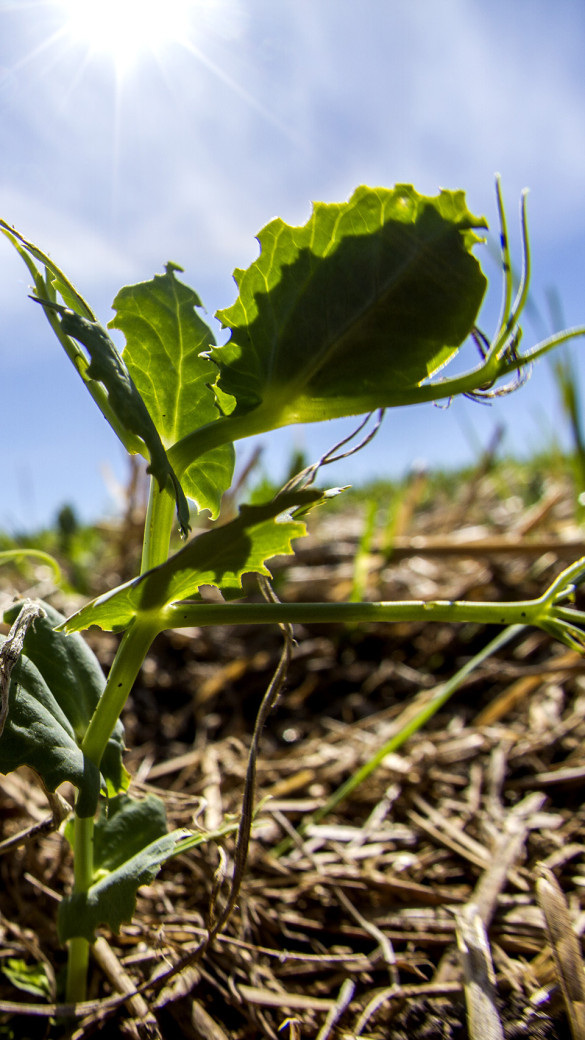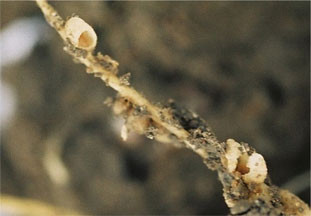Government mail service may be affected by the Canada Post labour disruption. Learn about how critical government mail will be handled.
Background
Pea leaf weevil (Sitona lineatus) is an insect pest that feeds on the nitrogen fixing nodules of host legumes (larvae) and leaves and growing points of host seedlings (adults).
Native to Europe, the pea leaf weevil (PLW) was first identified in Alberta by Agriculture and Agri-food Canada entomologist Dr. Bob Byers. The first record of this insect attacking peas in Alberta was in 2000 near Lethbridge, Alberta. Subsequent surveys have revealed considerable range expansion and increasing damage.
In southern Alberta, peas are the major crop at risk of economically significant damage. PLW adults do feed on dry beans but the damage is usually minor. Most losses result from larval feeding on nitrogen-fixing nodules.
Identification
The adult (Figure 1) is slender, greyish-brown and about 5 mm long. Adult PLW can be confused with the sweet clover weevil. PLW can be distinguished by the presence of 3 light-coloured stripes extending length-wise down the thorax and sometimes the abdomen of the pea leaf weevil.
PLW larvae are C-shaped, light milky white in colour with a dark brown head, legless, cylindrical, soft and fleshy, and 3.5 to 5.5 mm in length (Figure 2).
Figure 1. Adult Pea Leaf Weevil

Figure 2. Pea Leaf Weevil Larva

Where it’s found
The first record of this insect attacking field pea in Alberta was in 2000 near Lethbridge. Since then, PLW's range has expanded to north of Edmonton (2020). In Alberta, the pest occurs commonly in pea fields south of Highway #1 with density of the insect and resulting damage increasing towards Lethbridge.
Since 2001, crop insect surveyors carry out annual pea leaf weevil surveys that help predict PLW range and levels of damage. Surveyors visit pea fields from Warner to Peace River.
Life cycle
Under Alberta conditions, the PLW produces one generation per year. The PLW spends the winter as an adult beetle surviving on alfalfa and other perennial legumes.
Spring weather conditions can alter the timing and severity of PLW damage. Overwintering adult weevils fly or walk from their winter feeding grounds in perennial legume plants to nearby pea fields when spring temperatures rise above 17 degrees C.
Weevils arrive early in pea fields if warm temperatures above 20 degrees C persist for more than a few days in late April or early May. This potentially corresponds with higher pea yield losses. Alternatively if cool weather occurs during the same period, pea yield is generally not as compromised. Especially when the crop advances past the 6th node stage before the weevils arrive.
The female lays 1,000 to 1,500 eggs in the soil near or on developing plants in May through June. Upon hatching, larvae then move to the nodules where they feed. Larvae undergo 5 instars and feed on Rhizobium nodules then pupate in the soil.
New adults that emerge later in the growing season (late July through August) search for any pulse crops to continue feeding before overwintering.
The adult is attracted to feed on annual legume crops like field pea, faba bean, lentil and bean. However, it it only reproduces on pea and faba bean.
Damage
To continue their reproductive cycle for another year, adult weevils prefer to lay eggs in soil near field pea or faba bean seedlings. Root nodules of lentil or other legume crops are generally not affected.
Eggs are laid in the soil near the stem of pea plants. After hatching from the eggs, the larvae proceed downward to primarily feed on pea nodules resulting in partial or complete inhibition of nitrogen fixation by the pea plant.
Prior to egg laying, adult adult PLW insects feed on the leaf margins, resulting in a notching or scalloping leaf appearance (see Figure 3). The serious plant damage occurs from nodule destruction.
Figure 3. Pea Feeding Damage

Larvae feed on the nitrogen-fixing nodules of legume species, resulting in partial or complete inhibition of nitrogen fixation by the plant (Figure 4).
Figure 4. Larvae Feeding on Nodules

Control
As a preventative measure, some producers apply an insecticidal seed treatment to pea seeds prior to planting. Research has shown that seed treatment is much more effective in decreasing losses from PLW than foliar treatment. Applying broad spectrum insecticides also kills beneficial insects like ground beetles that are natural enemies of PLW.
Fields with high levels of residual nitrogen in the soil, such as those with manure inputs, are less likely to suffer yield losses from PLW and should not require control measures. This is because the pea plant can rely on soil nitrogen instead of its own nitrogen fixation for adequate growth.